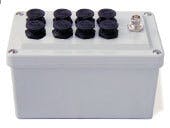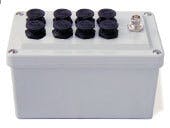New submersible data monitor
Here’s the new Data Dolphin 320 data monitor, a submersible piece of equipment. It offers NEMA 6P/IP68 protection for laboratory-grade accuracy in the oil field. Units promise reliable data monitoring and recording in temperature ranges of -40º C. to more than +60º C.
Four single ended or differential high precision inputs provide 24-bit digital to analog conversion. Built-in analog and digital filters eliminate the need for external signal conditioning. Four standard precision inputs accept pulse, on-off status, event start-stop, and analog signals with 10-bit digital to analog conversion. Wireless communication options include cellular modem, spread spectrum radio, or WiFi. Standard wired communications are also provided using RS-232 serial connections.
Data are stored in a nonvolatile flash memory for worry-free, long-term storage. Data are housed inside a database structure, which allows adding or deleting of inputs and changing of the sample rate, without having to restart the data monitor. Based on an average sampling rate of 5 min on two inputs, it would take more than 3 years for the DD-320’s memory to reach capacity, the firm notes.
Source: Scientific Technologies Inc., Automation Products Group, 1025 W. 1700 North, Logan, UT 84321-1713.
Software supports 64 bit HP-UX for all analysis types
This company’s latest finite element analysis software release, V19.1, features all-new support for the 64-bit HP-UX operating system for all analysis types.
Now, UNIX work station users can simulate engineering analyses of their product designs with a range of simulation capabilities including static stress and mechanical event simulation with linear and nonlinear material models, linear dynamics, steady-state and transient heat transfer, steady and unsteady fluid flow, electrostatics, and full multiphysics.
V19.1 also features a new gasket material model and element for accurately simulating mechanical seals, improved automatic report generation including the ability to publish to the PDF file format, the capability to calculate equilibrium temperature from heat transfer analysis results, and the ability to display fluid flow results as streak lines for improved visualization of flow throughout a fluid domain.
Source: Algor Inc., 150 Beta Drive, Pittsburgh, PA 15238-2932.



